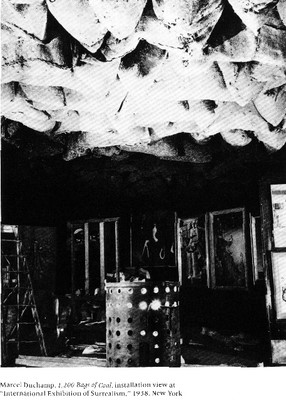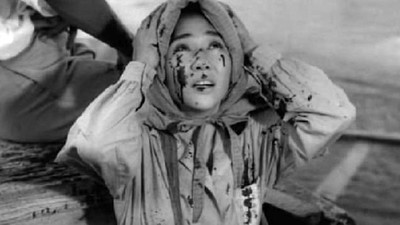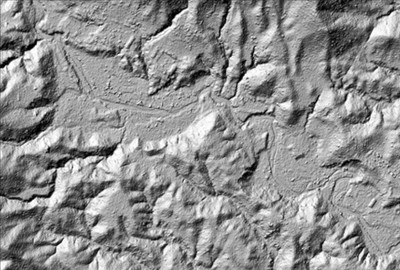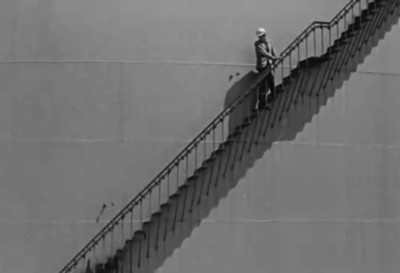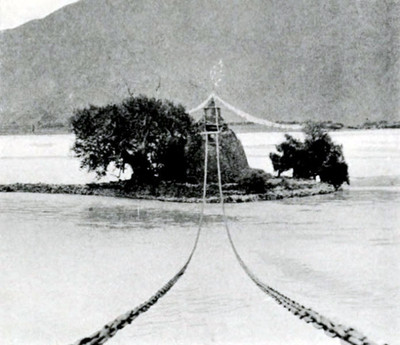This Is Shell
Piston rhythms deliver a perpetual drumming, acting as a ground for montaged glimpses of the dispersed operation sites of a single resources corporation. The tribal beats that layer these trans-geographic images—the insatiable pneumatic repetition of a motor combustion engine—invoke a so-called primal realm of power, inducing the hypnotic conviction that there is no scarcity possible.
As the film progresses, we begin to access an infrastructure grid of pipelines running horizontally as accumulating circuits, but they are only revealed as neat abstract flashes. Amidst the pounding drums it appears we are hearing the imperial soundtrack to a Kipling-esque jungle entry, in which a doubly fearful and desirous atmosphere anticipates the unveiling of a territory and its subsequent disposal to arriving forces.
So begin the opening scenes of This is Shell, a promotional film commissioned by the Anglo-Dutch corporation Royal Dutch Shell in 1970. The film’s director, Geoffrey Jones, was a leading figure in the genre of ‘industrial documentary’, producing renowned works throughout the 1960s and ‘70s for British Transport Films as well as for the film departments of British Petroleum and Royal Dutch Shell. He eventually held the position of supervisory director of animation at the Shell Film Unit, where he continued to innovate a kinetically charged cinema of industry.
Coming from a background in advertising Jones actively refused voice-over commentary throughout his filmmaking, shrinking the time of the documentary to that of the advertorial. Jones generated deployments of narrative images enmeshed within rhythm schemes, thereby unleashing the corporation-as-image. In This is Shell, the graphic notation of the company logo enters this automated timeline of footage as an official seal—a stamp of authorization rendering a coherent trans-spatial entity.
In this exposé-style staging of oil, what unfolds is a choreographic suspension—from the nighttime view of a power plant, to the off-shore oil rig, to elevator shafts, an overland desert dissecting pipeline, IBM technology and strategy meetings—oil is dramatized as a state of transfer via the trope of an ‘open secret’. And yet we know this fabricated mobility is far from the stench of the sitting reservoirs from which our carboniferous economy is satiated.
While oil is revealed, the source of its power is not. This behind-the-scenes viewing lifts the curtain only to press forward the meta-image of a corporate iconotype, insatiable in its transmutation of all footage into official communiqué. The myth of global capital is also such a structure of suspension—it attempts to turn society into a non-medium, that is: a mere reflection pool permitting infinite self-replication.
Bare Earth Construct
As a global imaging technology LiDAR (Light Detection And Ranging) is an adaption of RADAR, transposing its feedback of sonic signals to laser emissions in order to produce ‘bare earth constructs’ as digitized three-dimensional reliefs. LiDAR became available shortly after the development of laser technology in the 1960s. However, its use as an aerial scanning device was contingent upon a later coupling with the U.S. Department of Defense’s Global Positioning Systems (GPS) in the 1980s.
Rather than generating photographic evidence of territory as per satellite imaging, LiDAR emits laser signals so that a spectral position may be conceived via feedback, and as a multiple sculpting of data grids. This sort of visual operation is a mode of hyper-scanning that defies all human capacity toward memory and placement.
This machinic and suspended eye seeks the divestment of human bodies and the transmutation of earth surface into data— into the regime of ‘the global’, with striations of latitude and longitude, as an earth body that swells within financial abstractions of an algorithmic network.
As Gayatri Chakravorty Spivak notes: “the spectralization of the rural” and its conversion into “a database for pharmaceutical dumping, chemical fertilizers, patenting of indigenous knowledge, big dam building and the like”1 conveys the mode by which ‘the urban’ re-enacts the logic of LiDAR technology—structuring knowing through measures of distance and separation.
The Mosquita region on the Caribbean coast of Honduras is the legendary home of the Ciudad Blanca, a mythic pre-Colombian city rumored to dwell among some of the world’s most remote so-called virgin rainforest. The origins of the myth dates to the Spanish Conquistador Hernán Cortes, who sent correspondence in 1526 to the Spanish Emperor Charles V stating: “So wonderful are the reports about this particular province, that even allowing largely for exaggeration, it will exceed Mexico in riches, and equal it in the largeness of its towns and villages…”2.
Interest in the Ciudad Blanca re-emerged in the nineteenth century as part of a greater wave of fascination for ‘Lost Cities’—speculative pockets of an alterity of the prior3 that arose around the time of the vanishing of worldly frontiers. Reports of ‘sightings’ continued through the twentieth Century notably including American aviator Charles Limburg during a flight over Honduras in 1927. Despite numerous expeditions throughout the twentieth century, the city-as-treasure remained elusive—an unfixed and unverifiable murmur.
Frustrated with the impassable forest vegetation and surface imaging of satellite photography, documentary filmmaker Steve Elkins initiated a project in 2102 to virtually de-foliate the thick jungle canopy through LiDAR penetration. Seeking to discern the spectral matter of legend as a ground-based target, the project team blanketed the suspected area with as many twenty five to fifty laser pulses per square metre—a total of more than four billion laser ‘shots’.
Hailed by Honduras’ President Porfirio Lobo within a rubric of national claims, the resulting image-as-determination remains in dispute by archeological scholars. Its depiction of ‘bare earth’ fails, as it must, to reconcile measure with legend—just as neither is equipped to address the earth body in its undecidability and in its paranational condition. The project of scanning is here also one of prospecting and essentially a meeting with the sediment of refusal. A refusal to be ‘found’ by such a discerning aerial eye is an agential position within the terms of planetarity4.
Essential Linkage
Tangtong Gyalpo was a Tibetan Buddhist adept, an engineer, architect, poet, painter, philosopher, and healer, who developed a meditation practice on the longevity of life in the fourteenth and fifteenth centuries. While the exact year of his birth and death continue to be debated, it has been noted that he lived up to 125 years at least and some even claim that he lived well into the eighteenth century. Known as ‘Madman of the Empty Valley’ (Lung Stong Symon Pa), Gyalpo is considered one of the three great Drubthobs or ‘divine madmen’ in Tibetan history, who circulated their teachings through syncretic methods, embracing sociality and adopting labor practices alongside meditation, pilgrimage, and the spread of Buddhist values. Through the excessive inter-crossings of Gyalpo’s work, the body is conceived as an apparatus that fabricates infrastructural spanning of devotional geo-forms and labored lands.
The radical potential of sacred geography in its expressivity of ‘divine madness’ may be understood through Gyalpo’s efforts to build iron chain-link bridges across the Himalyan region throughout his life. Many of these bridges—constructed in the fifteenth century—exceeded the length of 100 meters, while bridges over twenty meters were considered engineering feats in Europe up until the seventeenth century. The suspension bridge in this mode is also a heterotopia, a construct of human effort scheming against the swelling river to allow for an artificial conjuncture. This sublime place is however, also a space to move from the illusory body to the essential body—a zone ‘to be single-minded in that place of practice.’ Bringing landforms together through the bodies of people in a fragile manner, the bridge engineered was that conscious of its function, of the limits our bodies and the limits of our ability to deal with infrastructure.
Gyalpo is remembered as consistently meditating in mountain caves tinged with iron oxide. As votive figure, he is seated and draped in a cotton garment. His skin is a red-brown, to represent the color of fresh sheep liver but also conveying of iron rust itself. In one hand he holds an iron chain link and in the other, a longevity vase. This co-materiality of devotional being encompassed an extroversion, bringing together two schools of Buddhist thought to form the tradition of Chakzampa. This immensity of labor in merging traditions came also to bear witness as the largest and most significant of Gyalpo’s suspension bridges. Built in 1420 across the Yarlung Tsangpo, it simply came to be called Chazkam, or ‘Iron Bridge’. As with monastery building, pilgrimage, traditional Tibetan opera, meditation and other durative practices—the crossing of this bridge evinced wholeness conditioned by bodily reckoning conjoined with suspended passage.
Gyalpo is said to be one of the most travelled persons in Tibetan history. Having made journeys across the Indian subcontinent, his ‘travel’ was also an infrastructural connecting of Tibet, Bhutan, Nepal and Mongolia through bridge and monastery building projects5. His interdisciplinarity is similarly known of through the experiential grounding of having had over 500 spiritual teachers. These endeavors forged Gyalpo’s persona as a ‘planetary’ character whose foothold was not only ‘on the ground’, accessible purely through dwelling, but traceable as a perpetual effort of conceiving undecidable alterity, as with the indeterminable dimension of the suspension bridge itself.
Gyalpo either did not know his own age or actively refused to disclose his ‘real’ age. An episode occurred late in his life when he was asked about his age and stated: “I can be old and I can be young… to display emanations that are old, young and in the prime of life, it doesn’t matter how many years have passed.” His attainment of immortality is demonstrated through the Tibetan opera performances of the Aché Lhampo, which Tangtong Gyalpo founded as a form of entertainment as well as of fundraising while the iron bridges were being built. The quest for immortality is not to ‘out live’ but to remain suspended in a condition of life that is somewhat the condition of the alloy as observed in metallurgy. This desirable admixture may hence be understood as an immersive translation wherein a life that is enduring has become enfolded into an eternal logic—more precious than before as it enters a structure of intermattering6.
A Cloud of Debris
When asserted as an operation in the means of judgment, suspension may occur as an atmospheric condition, perceptible only in its most exaggerated form. Such thresholds of appearance and attention were a consistent enquiry of Marcel Duchamp, who theorized the technologies of art as manipulations of a ‘coefficient’ of visibility7. “I had been borrowed from the ordinary world by the surrealists”,8 he stated, and it is the continuation of borrowing that engrossed Duchamp, as did the staging of art as intrusions from the ‘ordinary world.’ This gestural seepage finds a spatio-temporal resonance in his famed 1200 Coal Sacks as part of the 1938 ‘Exposition internationale du surréalisme’ at the Galerie Beaux-Arts in Paris.
Guests walking into the central rooms of this exhibition entered a dark grotto with the smell of roasting coffee; the space was strewn with strange presences such as double beds, mannequins and revolving doors used to hang paintings and objects. Instead of a ceiling there were 1200 coal sacks suspended above an open stove. A rain of coal dust attacked the guests from above—the sacks were stuffed with newspaper and so despite the black rain remained inflated. The only light came from an electric bulb within the brazier and from torches handed to the visitors on Man Ray’s suggestion—a reminder of miner’s headlamps, perhaps? Thus the even light of the gallery was displaced by a tactile darkness of falling ash by which the museal prohibition of bodily contact was manipulated into multiple states of overexposure.
As Brian O’Doherty announces in his book, Inside the White Cube, with 1200 Coal Sacks Duchamp “invented” the ceiling, from this moment on there is “a seepage of energy from art to its surroundings”9. Duchamp occupied this realm of the ceiling—previously designated beyond speculation—through fundamental inversion such that there was no option but to become suspended in a state of consciousness around its hovering presence. In previous eras the ceiling was an escape to an elsewhere, or a window of aspiration—the heavens, its angels and cosmologies—but Duchamp undermined any hint of utilitarian or aspirational impulse. Instead there is an intrusion of debris all around; the revolving doors that one cannot pass through, the coffee that can be smelled but is nowhere to drink, the stove that emits light but refuses fire. The notion of the industry fair is here subverted to the hyperbole of a menacing technocracy.
The descent of ash materially prefaces the ultimate exhaustion of a carboniferous economy and its perpetual deferral in mind through seepage and states of exception10. Yet how do we know what it meant to stand within the dark grotto of Duchamp, becoming prone to its continuous impact? It seems compelling to pose here an alternative entrance for the deficiencies of art history in its chronicling of ‘the event’, which is a problem also of history itself. Continuing through these edges of what is known we may arrive at Black Rain, the 1989 film of Shohei Imamura. In the opening scenes, a view of the Hiroshima mushroom cloud cuts immediately to a boat headed towards the decimated city. For its passengers floating upon an inland sea, the time of radioactivity is endured as a foreshadowed descent toward a parasitic time of poisoned corporeality. The film’s protagonist Yasuko looks up to see the nuclear rain and hence raises her face towards the inky black droplets that fall upon her cheeks as a horrific condition of pure contact. As ‘fall-out’, the cloud is a dialectical form that is apparition as well as vaporized debris with corrosive effect.
Duchamp’s scenography meets the confrontational frame of Imamura’s visual tableaux in which crooked windows, charred bodies, ripped doors, piles of rubble intrude stubbornly. While picturing rehearsals of normalcy, both Imamura and Duchamp refuse to admit a clean aesthetic experience. The trope of dark falling matter fixes its protagonists into an irresolvable place. The sacks that appear as clouds are falsely inflated—we cannot know the limits of their artificiality and hence, their perennial leakage becomes doubly unknown and doubly toxic. In this undecidable realm, the operations of justice and of recovery become illegible, and become also progressively an ‘outside’—one of exception-as-illegitimation.
Nuclear fallout is an exceptional propulsion—between the event and the after-event—as that moment which freezes the affected subject into a condition of alienation that is a non-life. Like the historic iron suspension bridges of Tantong Gyalpo, the scenes from Black Rain and the 1200 Coal Bags of Duchamp also pose as architectures of exception. Their exceptionality bears the burden of an infrastructural consciousness driven by an essential suspension that binds landforms both to personal reckoning and to the social imaginary.
With thanks to Anjalika Sagar, Kodwo Eshun, Ekow Eshun and Daniel C. Baber.
- G.C. Spivak, Death of a Discipline, Columbia University Press, (New York, 2003), 98.↩
- C., Hernán, 'The Fifth Letter of Hernán Cortes to the Emperor Charles V. de Gavango', trans. Don Pascual, Printed for Hakluyt Society, (London, 1868), 118.↩
- E.A. Povinelli , 'Economies of Abandonment: Social Belonging and Endurance in Late Liberalism', Duke University Press, (Durham, 2011), 34.↩
- "Planetarity" is raised with reference to Gayatri Cakravorty Spivak’s proposition of the term and its epistemological operations in 'Economies of Abandonment: Social Belonging and Endurance in Late Liberalism', Columbia University Press, (New York, 2003), 72.↩
- Thangtong Gyalpo’s biographer, Gyurme Dechen records that the blacksmiths of Paro forged 7000 chain links and that he packed 1400 horse loads of 15 chain links each alongside with other baggage and have them brought to different places in Tibet.↩
- "Intermattering" as discussed by Daniel C. Barber in his recent presentation at the ICI Berlin 'Intelligence Against the World - Malcolm X on Race and the religion of Recognition', and as it appears in his book 'On Diaspora: Christianity, Religion, and Secularity', Cascade Books, (Eugene, 2011).↩
- 'The Creative Act', 1957, Duchamp's lecture in Houston, April 1957, in 'Art News', vol. 56, no. 4, (Summer, 1957), 28 –29.↩
- P. Cabanne, 'Dialogues With Marcel Duchamp, (I Like Breathing Better Than Working)', da Capo Press (Cambridge, 1979), 81.↩
- B. O’Doherty, 'Inside the White Cube: The Ideology of Gallery Space', Lapis Press & First University of California Press, (San Francisco, 1976, 2000).↩
- G. Agamben, 'State of Exception', University of Chicago Press, (Chicago, 2005).↩
